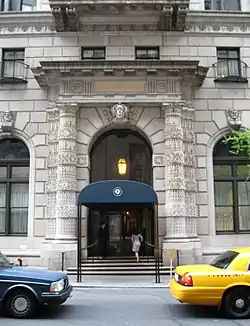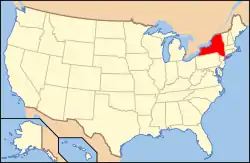University Club of New York
The University Club of New York (also known as University Club or UClub) is a private social club located at 1 West 54th Street at Fifth Avenue in Manhattan, New York. It received its charter in 1865, but the origins date back to the autumn of 1861 when a group of college friends, principally Yale alumni, founded the club hoping to extend their collegial ties. The club is not affiliated with any other University Club or college alumni clubs. The club is considered one of the most prestigious in New York City. [3]
University Club | |
 1 West 54th Street | |
   | |
| Location | 1 West 54th Street, Manhattan, New York City, New York |
|---|---|
| Coordinates | 40.7613°N 73.9756°W |
| Area | less than one acre |
| Built | 1899[1] |
| Architect | Charles Follen McKim of McKim, Mead, and White |
| Architectural style | Italian Renaissance Revival |
| NRHP reference No. | 80002726[2] |
| Significant dates | |
| Added to NRHP | April 16, 1980 |
| Designated NYCL | January 11, 1967 |
History
The first meeting was held in the rooms of the Columbia College Law School (now the Columbia University Law School), where Theodore Dwight, the Club's first president and a Hamilton College alumnus, was a professor. After several moves, the club took over an existing townhouse at 26th Street and Madison Avenue, in 1883.
Founded to celebrate the union of social duty and intellectual life, the Club states in its charter that the purpose of the organization shall be the "promotion of Literature and Art by establishing and maintaining a Library, Reading Room and Gallery of Art, and by such other means as shall be expedient and proper for such purposes." In addition to its many grand architectural features, the University Club hosts one of New York's great private art collections, with a particularly strong group of works by great American painters such as Gilbert Stuart and Childe Hassam, who featured the Club's facade in his work Allies Day, May 1917.
The club was all-male until 1987.[4]
Building
By the 1890s, with its membership limited by the size of its building to 1,500 resident members and 900 who lived elsewhere, the Club was looking for a larger space, because it had nearly 600 people on a waiting list to join. It acquired the St. Luke's Hospital site and proceeded to seek an architecture firm. The firm of Charles Follen McKim, William Mead and Stanford White, who were all members, got the architectural commission and went on to design what remains one of the grandest clubhouses of the city's prominent social clubs.
Erected in 1899, in a Mediterranean Revival Italian Renaissance palazzo-style, the building is particularly noted for its reading room (with ceiling murals by H. Siddons Mowbray modeled after the Vatican Apartments), dining room, and the attempt made by the architects to disguise a nine-story building behind what seems to be a three-story facade.
McKim, Mead and White commissioned Edward F. Caldwell & Co. to provide light fixtures for the University Club among other architectural commissions for the company.[5]
Notable areas
Reading Room
The Reading Room is located on the first floor adjacent to the lobby. It has several large arched windows overlooking the streets, flat pilasters along the walls and a high, flat gilded ceiling with a large fresco at the center.
Library
The Library is located on the fourth floor and is not open to the public. It was originally called the Club Library and was located on the Library Floor (second floor).[6] It has a gilded vaulted ceiling, dark wood paneling, sculpture busts and large arched windows. It is finely decorated with an overall decor reminiscent of the Borgia Apartments at the Vatican. There are approximately 100,000 books and periodicals. The bookcases are parallel arranged in rows having two levels with catwalks to access the second level. Club member and renown naval strategist Alfred Thayer Mahan wrote some of his treatises at the library.[7]
Main Dining Room
The main dining room is on the seventh floor. It has several large arched windows, marble floor, walls entirely covered by dark wood paneling with flat and round column pilasters also of wood, and a high, flat gilded ceiling with a large fresco at the center.
See also
- Columbia University Club of New York
- Cornell Club of New York
- The Harmonie Club of NYC
- Harvard Club of Boston
- Harvard Club of New York
- List of American gentlemen's clubs
- Metropolitan Club
- Penn Club
- Princeton Club
- Princeton Club of New York
- Williams Club
- Yale Club
- Yale Club of New York City
- List of New York City Designated Landmarks in Manhattan from 59th to 110th Streets
- National Register of Historic Places listings in Manhattan above 59th to 110th Streets
References
- "AIA Guide to New York City, 4th Edition, page 295
- "National Register Information System". National Register of Historic Places. National Park Service. July 9, 2010.
- Shipp, E. R. (June 6, 1987). "The University Club Votes to Take Women as Members". The New York Times.
- "Page Six: That Time Hillary Clinton Was Kicked Out of University club". New York Post. June 8, 2016.
- Doug, Dunlop. "Shedding Light on New York: Edward F. Caldwell & Co". Smithsonian Institution Libraries.
- Alexander, James Waddle. A history of the University Club of New York, 1865–1919, (New York: Charles Scribner's Sons, 1914), page 251.
- Alexander, A history of the University Club of New York, 1865–1919, pages 165-66, 262.
Further reading
- Horsley, Carter B. "The Midtown Book: The University Club". The City Review. Article about the building.
External links
| Wikimedia Commons has media related to The University Club of New York. |
- Official Site at universityclub.org
- "University Club". greatbuildings.com. Extensive list of sources]
- C., Justin (May 25, 2007). "University Club review". Yelp. Report of a visit to the gym.

